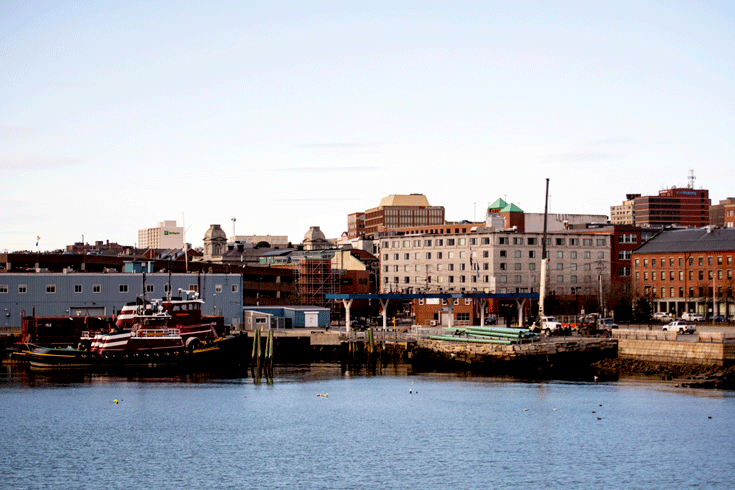Tucked between the shore and I-295 at the mouth of Portland’s Back Cove, the B&M Baked Beans cannery, built in 1913, was a landmark for city residents, tourists, and even mariners on Casco Bay, as well as the source of the aroma of cooking beans and molasses. For more than 60 years, the four-story factory’s 145-foot-tall brick chimney towered against the sky.
About six months ago, the chimney was deemed a safety hazard and taken down, the demolition of the iconic tower a first visual clue to the changes coming to the industrial site.
If all goes as planned, over the next five years or so, the Roux Institute of Northeastern University will build its new home at the site. The Institute touts itself as offering graduate education steeped in technology entrepreneurship and research. Among its focus areas are artificial intelligence, computer and data sciences, digital engineering, and advanced life sciences and medicine.
Its namesake and leader, David Roux, is a Lewiston native who made his mark with Lotus Software and Oracle.
Within 20 years, 4,500 students with related faculty and staff could occupy 350,000 square feet of laboratory and classroom space…
“Partnerships with industry, academia, and government set our education and research model apart,” the organization notes on its website. Among its partners in Maine are: Bangor Savings and Camden National banks, L.L. Bean, Idexx, Wex, Maine Health, and Unum.
The center aims to “build expertise at the intersection of humans and machines,” its site notes, aiming to create a tech corridor from Portland to Boston.
Roux’s initial foray into Portland began in late 2020 in offices on Fore Street, where Wex also is located. The permanent campus, at the site of the former B&M plant, is slated to open in 2024.
That project calls for as much as 250,000 square feet of classroom, office, and laboratory space, with room for some 1,750 students and 50 or so partner organizations.
Roux also hopes to build some 50,000 square feet of commercial business incubation space, 175-250 units of high-rise housing, and an additional 125,000 square feet of commercial space for retail and dining facilities and, ultimately, a hotel.
Within 20 years, 4,500 students with related faculty and staff could occupy 350,000 square feet of laboratory and classroom space, 500,000 square feet of office and laboratory space, 500-800 housing units, and 155,000 square feet of commercial space.
Documents prepared for the city show the site divided into six zones, each with a proposed maximum height limit for new construction. Along the shore in the southeast corner of the property, site of the main Roux Institute building, the height limit is 165 feet. In areas designated for future development, the height limits range from 150 to 210 feet.
The Roux Institute development could change the character of Portland, though other developments in the works are playing a part, including a 263-unit apartment building under construction at the corner of Temple and Federal Streets. That 190-foot, 18-story building will become the tallest building in Maine.
Many in Portland wonder how the Roux Institute will change the East Deering neighborhood and the city as a whole, and how it intends to integrate its development with its neighbors and Portland’s working waterfront.
The Initiative for Digital Engineering and Life Sciences (IDEALS) is the non-profit developer charged with turning the industrial site into a campus still open to the community at large for recreational use. Roux and the developer have addressed these issues in an ongoing series of meetings with members of the greater Portland and East Deering communities who are concerned about increased traffic on neighborhood roads and the shadows potentially cast by tall buildings.
In March, Margaret Angell, head of partnerships and strategic initiatives at the Roux Institute, and Sam Reiche, chief operations officer and head of real estate at IDEALS, met with members of the Portland Waterfront Alliance to address the issues surrounding the development, use, and public access to the project’s hundreds of feet of shoreline.
Roux “is still learning what they have as a site,” observed Tom Meyers, chairman of the Waterfront Alliance executive committee. The initial plans show “a lot of focus on recreation and public access, but not much focus on the working waterfront,” he said.
“If they’re putting all that brain power into different things,” Meyers said, “if they put some of it into the maritime domain it would be really nice.” He sees “a great opportunity for them to learn” about collaboration with Portland’s working waterfront community and its blue economy.
“Other big developments have come to realize the value of the working waterfront to their organizations,” Meyers said.
Reiche said the overall goal of the development was “to create a vibrant location where people want to be collaborative.” The housing proposed for the site would be “mostly for graduate students,” he said, but the open space on campus would be public and available for use by “as broad a community as possible.”
IDEALS is working with Portland Metro to develop direct bus connections to provide access from downtown Portland, Reiche said, and a private shuttle service might a possibility. Expanding bike access is “very, very critical,” and discussions are under way to arrange connections with existing bike trails allowing traffic both ways beneath the I-295 Tukey’s bridge to better connect with East Deering.
Also under consideration is establishment of water taxi service between the campus and the Portland waterfront.
The site of the planned Roux campus “has been closed off to the public for a long time,” Reiche said. “This is an opportunity to open a unique site to the public.”





